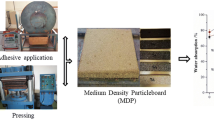Abstract
The problem with discoloration, due to fungal growth, of wooden outdoor constructions seems to have increased in recent years. One reason for this increase might be an impact of new drying methods of timber. Modern kiln drying methods use high temperatures in an effort to shorten the drying process, which leads to fast capillary water transport and subsequently redistribution and accumulation of dissolved substances at the surface. These can then be used as nutrients by fungi. In this study, wood was dried according to different simulated drying schedules. The mould resistance of the timber was then tested. Wood dried at room temperature was used as a reference. No differences could be confirmed at the end of the test; mould growth was extensive on all the samples. However, mould growth started earlier on the kiln-dried samples than on air-dried timber. As for the discolouring fungus, there was a clear difference between wood dried at room temperature and kiln-dried wood, though no difference could be established between the two artificial methods.
Zusammenfassung
In den letzten Jahren ist eine Zunahme des Verfärbungsproblems bei Holzkonstruktionen im Außenbereich aufgrund von Pilzbefall zu verzeichnen. Als ein Grund dafür wurde der Einfluss neuer Trocknungsmethoden von Schnittholz genannt. Moderne technische Trocknungsverfahren verwenden hohe Temperaturen, um die Trocknungszeit zu verkürzen. Dies führt zu schnellem Kapillarwassertransport und dadurch zu einer Verlagerung und Akkumulierung gelöster Stoffe an der Oberfläche, welche dann den Pilzen als Nährstoffe dienen. In dieser Studie wurde Holz mittels verschiedener Trocknungsabläufe getrocknet und anschließend auf Schimmelbeständigkeit geprüft. Bei Raumtemperatur getrocknetes Holz diente als Kontrollprobe. Bei Versuchsende konnten keine Unterschiede festgestellt werden; alle Prüfkörper wiesen starkes Schimmelwachstum auf. Allerdings begann das Schimmelwachstum bei technisch getrockneten Prüfkörpern früher als bei luftgetrocknetem Schnittholz. Bei den holzverfärbenden Pilzen gab es einen deutlichen Unterschied zwischen Holz, das bei Raumtemperatur getrocknet wurde, und technisch getrocknetem Holz. Jedoch konnte kein Unterschied zwischen den beiden technischen Trocknungsprogrammen festgestellt werden.









Similar content being viewed by others
References
Eagen R, Brisson A, Breuil C (1997) The sap-staining fungus Ophiostoma piceae synthesizes different types of melanin in different growth media. Can J Microbiol 43(6):592–595
Fleet C, Breuil C, Uzunovic A (2001) Nutrient consumption and pigmentation of deep and surface colonizing sapstaining fungi in pinus contorta. Holzforschung 55(4):371–378
Frühwald E, Li Y, Wadsö L (2008) Image analysis study of mould susceptibility of spruce and larch wood dried or heat-treated at different temperatures. Wood Mat Sci Eng 3(1):55–61
Gadd GM (1980) Melanin production and differentiation in batch cultures of the polymorphic fungus Aureobasidium pullulans. FEMS Microbiol Lett 9(3):237–240
Grant C, Hunter CA, Flannigan B, Bravery AF (1989) The moisture requirements of moulds isolated from domestic dwellings. Int biodeterioration 25:259–284
Long KD (1978) Redistribution of simple sugars during drying of wood. Wood Sci 11(1):10–12
Schmidt O (2006) Wood and tree fungi: biology, damage, protection and use. Springer, Berlin
Sehlstedt-Persson SMB (1995) High-temperature drying of scots pine. A comparison between HT- and LT-drying. Holz Roh- Werkst 53(1):95–99
Terziev N (1996) Low-molecular weight sugars and nitrogenous compounds in Scots pine: contents in the stem, redistribution during drying of lumber and practical consequences. Swedish University of Agricultural Sciences, Uppsala
Theander O, Bjurman J, Boutelje JB (1993) Increase in the content of low-molecular carbohydrates at lumber surfaces during drying and correlations with nitrogen content, yellowing and mould growth. Wood Sci Technol 27(5):381–389
Viitanen H, Bjurman J (1995) Mould growth on wood under fluctuating humidity conditions. Material und Organismen 29(1):27–46
Acknowledgments
The present research was part of the research programme WoodBuild co-ordinated by SP Technical Research Institute of Sweden. The research was financed by VINNOVA, the Swedish Federation of Forest Industries, and a number of companies in the forest and building sector.
Author information
Authors and Affiliations
Corresponding author
Rights and permissions
About this article
Cite this article
Johansson, P., Wamming, T., Bok, G. et al. Mould growth on kiln-dried and air-dried timber. Eur. J. Wood Prod. 71, 473–481 (2013). https://doi.org/10.1007/s00107-013-0699-y
Received:
Published:
Issue Date:
DOI: https://doi.org/10.1007/s00107-013-0699-y




